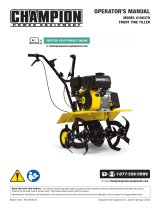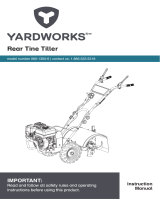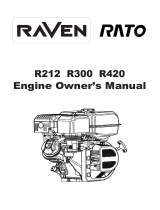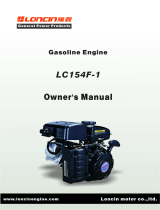
100862 - FRONT TINE TILLER
IMPORTANT SAFETY INSTRUCTIONS
4
IMPORTANT SAFETY INSTRUCTIONS
This machine meets voluntary safety standard B71.8 – 1996,
which is sponsored by the Outdoor Power Equipment Institute,
Inc., and is published by the American National Standards
Institute.
Training
1. Carefully read this Operator’s Manual and any other literature
you may receive. Be thoroughly familiar with the controls and
the proper use of the tiller and its engine. Know how to stop
the unit and disengage the controls quickly.
2. Never allow children under age 16 to operate the tiller. Never
allow adults to operate the tiller without proper instruction.
3. Keep the area of operation clear of all persons, particularly
children and pets.
4. Keep in mind that the operator or user is responsible for
accidents or hazards occurring to other people, their property,
and themselves.
Preparation
1. Thoroughly inspect the area where the tiller is to be used and
remove all foreign objects.
2. Be sure all tiller controls are released and both wheels are in
the Wheel Drive position before starting the engine.
3. Do not operate the tiller without wearing adequate outer
garments. Avoid loose garments or jewelry that could get
caught in moving parts.
4. Do not operate the tiller when barefoot or wearing sandals,
sneakers, or light footwear. Wear protective footwear that will
improve footing on slippery surfaces.
5. Do not till near underground electric cables, telephone lines,
pipes or hoses. If in doubt, contact your telephone or utility
company.
6. Warning: Handle fuel with care; it is highly flammable and its
vapors are explosive. Take the following precautions:
6a. Store fuel in containers specifically designed for this
purpose.
6b. The gas cap shall never be removed or fuel added while
the engine is running. Allow the engine to cool for several
minutes before adding fuel.
6c. Keep matches, cigarettes, cigars, pipes, open flames and
sparks away from the fuel tank and fuel container.
6d. Fill fuel tank outdoors with extreme care. Never fill fuel
tank indoors. Use a funnel or spout to prevent spillage.
6e. Replace all fuel tank and container caps securely.
6f. If fuel is spilled, do not attempt to start the engine, but
move the machine away from the area of spillage and
avoid creating any source of ignition until fuel vapors have
dissipated.
7. Never make adjustments when engine is running (unless
recommended by manufacturer).
Operation
1. Do not put hands or feet near or under rotating parts.
2. Do Not attempt to till with tines in reverse
3. Exercise extreme caution when on or crossing gravel drives,
walks, or roads. Stay alert for hidden hazards or traffic. Do
not carry passengers.
4. After striking a foreign object, stop the engine, remove the
wire from the spark plug and prevent it from touching the
spark plug. Thoroughly inspect the machine for any damage
and repair the damage before restarting and operating the
machine
5. Exercise caution to avoid slipping or falling.
6. If the unit should start to vibrate abnormally, stop the engine,
disconnect the spark plug wire and prevent it from touching
the spark plug, and check immediately for the cause.
Vibration is generally a warning of trouble.
7. Stop the engine, disconnect the spark plug wire and prevent
it from touching the spark plug, whenever you leave the
operating position, before unclogging the tines,
or when making any repairs, adjustments or inspections.
8. Take all possible precautions when leaving the machine
unattended. Stop the engine. Disconnect the spark plug wire
and move it away from the spark plug.
9. Before cleaning, repairing, or inspecting, stop the engine and
make certain all moving parts have stopped. Disconnect the
spark plug wire and prevent it from touching the spark plug to
prevent accidental starting.
10. Never use the tiller unless proper guards, plates, or other
safety protective devices are in place.
11. Do not run the engine in an enclosed area. Engine exhaust
contains carbon monoxide gas, a deadly poison that is
odorless, colorless, and tasteless.
12. Keep children and pets away.
13. Be aware that the tiller may unexpectedly bounce
upward or jump forward if the tines should strike
extremely hard packed soil, frozen ground, or buried
obstacles like large stones, roots, or stumps. If in
doubt about the tilling conditions, always use the following
operating precautions to assist you in maintaining control of
the tiller:


























